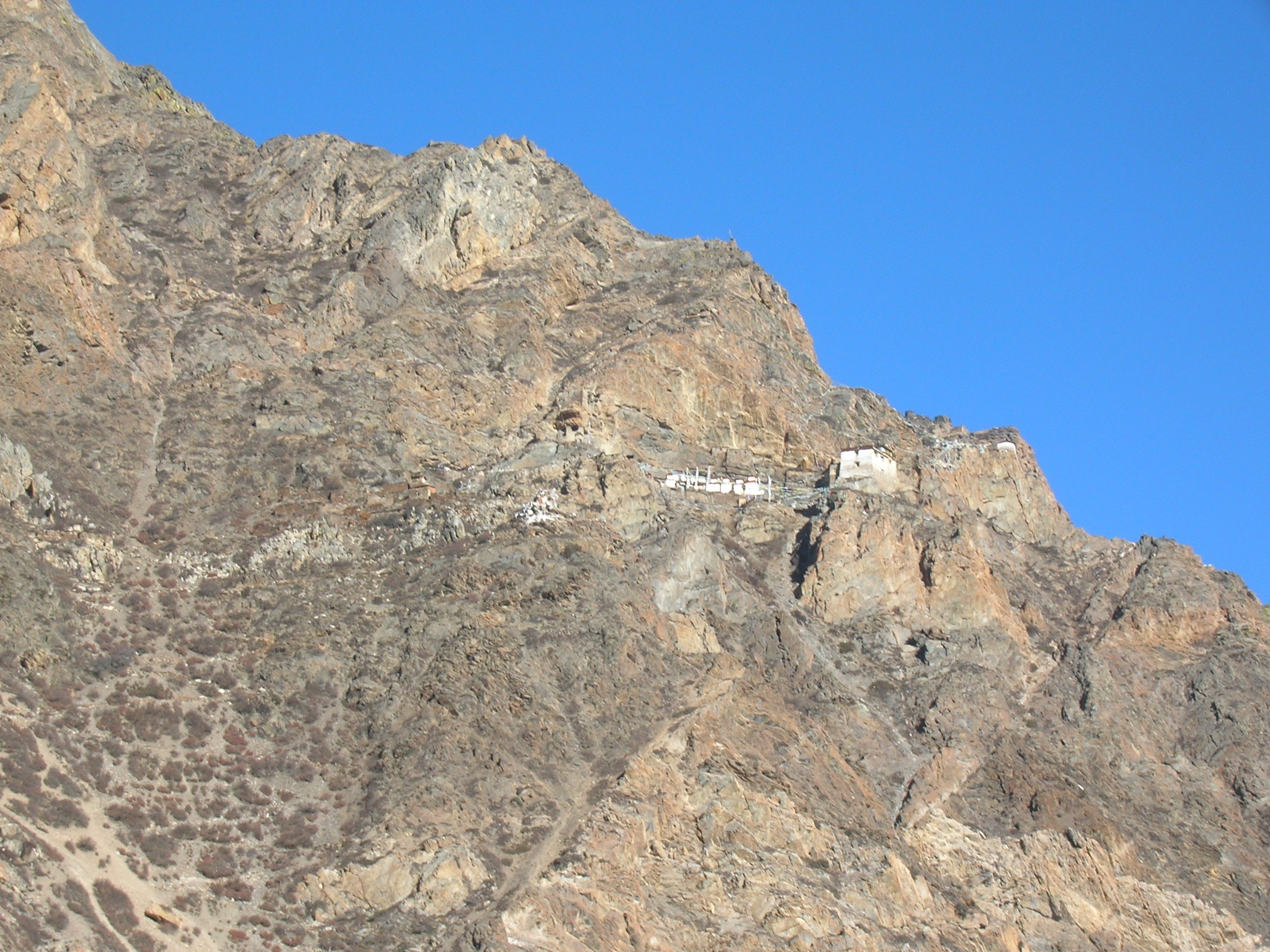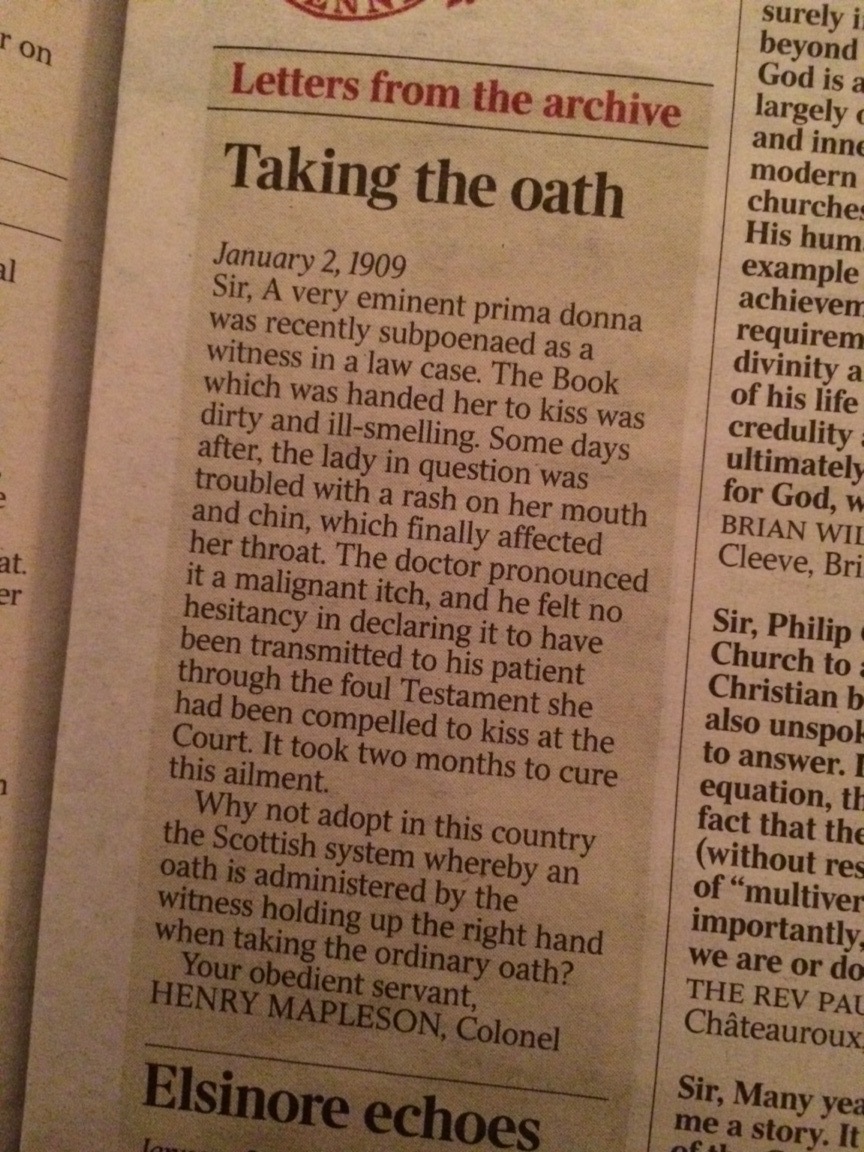 One of the broadsheets found in their archive this sorry story of a witness in a law case and the ‘foul Testament’ from which she contracted a ‘malignant itch’ after kissing it by way of swearing her oath. While a certain ’eminent prima donna’ of our own times has met with other troubles after her recent appearance as a witness in a high-profile trial, she has at least avoided this troublesome complaint. The original correspondent would be pleased to know that kissing the Book is no longer necessary in Court…
One of the broadsheets found in their archive this sorry story of a witness in a law case and the ‘foul Testament’ from which she contracted a ‘malignant itch’ after kissing it by way of swearing her oath. While a certain ’eminent prima donna’ of our own times has met with other troubles after her recent appearance as a witness in a high-profile trial, she has at least avoided this troublesome complaint. The original correspondent would be pleased to know that kissing the Book is no longer necessary in Court…
and meanwhile a couple of wags at the New York Times have come up with a witty prescription for the rebranding of print… Happy new year!
A colleague sent me a link to a slightly creepy article in the New York Times in which (as he neatly put it) ‘GCHQ meets CMT’. It seems that it’s not just governments and social media outfits that are intent on spying on us. It’s also publishers, who thanks to the burgeoning of ebooks are pioneering new ways of knowing what we read and how we respond to it.
There are all sorts of ways in which such information might be used, but the article seems to be most excited about the possibility of taking a focus-group approach to creative writing. Just as a big-budget movie might be tested out on an audience to find ways of increasing its appeal prior to general release, so novelists will now be able to find out what their readers like and ‘give them more of it’. I recoil in horror from the whole idea, but doubtless it will help someone somewhere to make a fast buck…
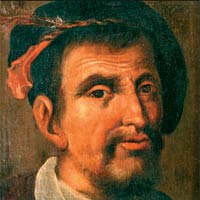 The one-day workshop on ‘The Biblioteca Hernandina and the Early Modern Book World’, held at the Parker Library at Corpus Christi College, Cambridge on Tuesday, was a richly stimulating event. Organised by Edward Wilson-Lee and José María Pérez Fernández, the workshop convened a group of experts to discuss aspects of the enormous library of Hernando Colón, son of Christopher Columbus, who after some early journeying with his father in the New World devoted much of his life to travelling in search of books.
The one-day workshop on ‘The Biblioteca Hernandina and the Early Modern Book World’, held at the Parker Library at Corpus Christi College, Cambridge on Tuesday, was a richly stimulating event. Organised by Edward Wilson-Lee and José María Pérez Fernández, the workshop convened a group of experts to discuss aspects of the enormous library of Hernando Colón, son of Christopher Columbus, who after some early journeying with his father in the New World devoted much of his life to travelling in search of books.
José María and Edward kicked things off by offering a potted biography of Colón and an account of his life in book-buying. His shopping expeditions began in Spain in 1510, moved on to Italy in 1512, and subsequently took him to Germany, France, the Netherlands and England. He also sent agents out to extend his collections, instructing them to focus on cheaper and more unusual small-format books rather than buying the kind of expensive folios that could be obtained anywhere. Along the way he paid visits to heroes such as Erasmus, taking care to receive at least one book as a gift on each visit, and he may have befriended Albrecht Durer, whose works he added to his vast collection of printed woodcuts and engravings. The result was a library that dwarfed other collections of the day, boasting more than 15,000 titles. A number of catalogues witness his struggle not merely to list the books he owned, but also to render them useful. Rather than letting the books die on the shelves, he sought to release their contents through a massive project of indexing and epitomizing–a project that was doomed to failure, and which was left unfinished at his death in 1539.
One of the most striking features of Hernando’s collecting was his enthusiasm for ephemera, and in the morning session Miguel Martínez explored his penchant for broadside ballads, newsbooks and controversial pamphlets–the sort of cheap publications that would have flooded the streets of his native Seville. Despite their former ubiquity, such items now survive in single copies if they survive at all, and they no longer extant in Cólon’s library as it survives in Seville Cathedral. Andrew Pettegree picked up this topic of lost books, suggesting that as many as two-thirds of all early modern editions may have disappeared without trace. He explained how the editors of the Universal Short Title Catalogue are using a variety of archival records to infer the existence of lost editions–10,000 of them so far–which are being added to the catalogue to create a much fuller map of pre-1600 print culture. The third paper in this session focused on a particular book, Christopher Columbus’s copy of Marco Polo’s account of China. Ana Carolina Hosne reconsidered the question of how far Columbus was aware of Polo’s work when he set out to pioneer a westward route to Cathay–given that his copy in the Biblioteca Hernandina post-dates his second expedition of 1498.
The afternoon session began with Tess Knighton on Cólon’s music books. As well as setting Cólon in relation to other Spanish collectors, Knighton’s talk challenged the idea that all of Cólon’s music-buying would have required foreign travel. Although it is clear that some of his shopping for the earliest printed polyphonic music was done in Italy, the mobility of books in the period was such that a range of international publications would have been on sale in Seville. Alexander Marr took on the subject of prints, exploring the curious blind-spots in Cólon’s massive collection of woodcut and intaglio images and asking whether these point us to his personal tastes, or merely to the financial constraints imposed by someone who seems to have watched every maravedí as he trawled the seas of ink. Vittoria Feola concluded the session by considering the fate of the Hernandina library in relation to other great collections, including the library of Elias Ashmole, which she is currently cataloguing. Her account of the unpredictable twists and turns of books-as-property suggested that there are many ways in which a library can be ‘lost’. The most perfectly preserved collection can be unknown and unused, kept in a gilded cage with no catalogue to guide readers to its contents.
The conference closed with a round-table discussion which started out from a fascinating memoir of Cólon by his servant Juan Pérez, and which moved on to attempt to integrate the day’s findings. Was Cólon a bad collector, someone who put quantity above quality and whose cataloguing techniques were little better than quixotic? What should we make of his buying of books in languages he couldn’t read and that he considered ‘barbaric’ (such as his large collection of German Lutheran pamphlets)? And what sense can we make of his ephemeral collecting? Does his investment in the popular mark him out as exceptional, or does our propensity to find it surprising merely reveal the distortions in our view of the period?
You can read more about the project, and see some photos from books in Cólon’s collections, here.
Cambridge University Library’s Entrance Hall cases are hosting what is believed to be the first ever exhibition of colour printmaking in Tudor England, 1485-1603. These brightly printed pictures transform our understanding of the spread of technologies of visual communication in the English Renaissance. The exhibition is curated by Dr Elizabeth Upper and presents aspects of her research as the 2012/13 Munby Fellow of Bibliography at Cambridge University Library.
The exhibition can be viewed during Library opening hours until 18 January 2014. See https://exhibitions.lib.cam.ac.uk and, for further information, https://specialcollections.blog.lib.cam.ac.uk/?p=6612#more-6612.
Faculty of English, University of Cambridge, 30 June – 2 July 2014
Under the auspices of the Centre for Material Texts
Writing Britain is a biannual event which aims to draw on a range of approaches and perspectives to exchange ideas about manuscript studies, material culture, multilingualism in texts and books, book history, readers, audience and scribes across the medieval period. The 2014 iteration of the Writing Britain Conference will take place in the English Faculty at the University of Cambridge under the auspices of the Centre for Material Texts. Some of the topics which we are keen to explore are literary and non-literary agencies and their significance and/or relevance in the medieval period across British medieval written culture in English, French, Latin, Norse and the Celtic languages. More broadly, we are interested in other questions such as: How did local writers, compilers and readers use writing to inscribe regional identity within broader conventions or, on the other hand, impress ‘universal’ practices and constructs on local populations? What were the different markets for books? Can we characterize their developments and differences? What new or existing methodologies can be employed to localise texts and books across Britain? What is the role of the Digital Humanities in the study of medieval book culture?
Plenary speakers: Jonathan Wilcox (University of Iowa), Richard Beadle (University of Cambridge) and Simon Horobin (University of Oxford)
We welcome proposals from scholars working on any aspects of British medieval written culture up to 1500. Please visit our conference web site in order to submit an abstract (300 words or fewer) for a twenty-minute paper. Please send your abstract by 20 February 2014. Abstracts from postgraduate students are welcome and graduate rates will be provided. For further information please visit the website where contact details of the organisers will also be available.
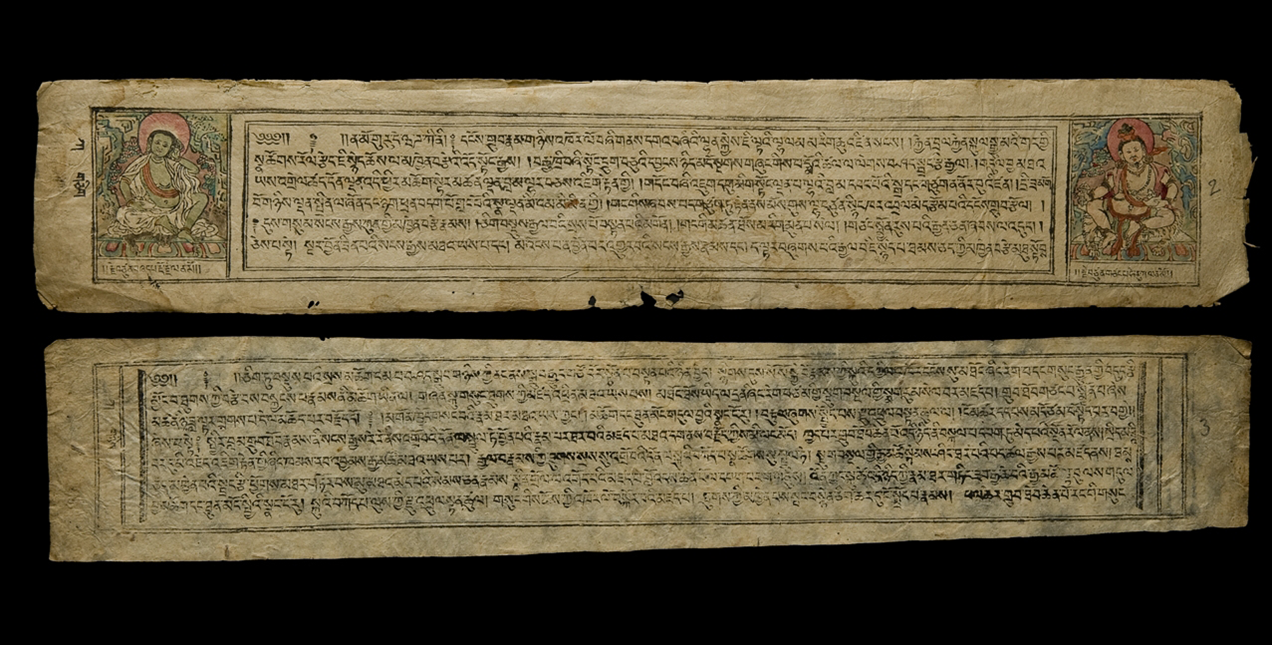 Have just spent a fascinating couple of days at a conference on ‘Printing as an Agent of Change in Tibet and Beyond’, a spin-off from the project on ‘Transforming Technologies and Buddhist Book Culture’ based in the Department of Social Anthropology in Cambridge. It’s been really exciting to see how the picture of Tibetan printing, stretching back to the 12th century, is being pieced together with great patience and smartness by a very devoted community of academics.
Have just spent a fascinating couple of days at a conference on ‘Printing as an Agent of Change in Tibet and Beyond’, a spin-off from the project on ‘Transforming Technologies and Buddhist Book Culture’ based in the Department of Social Anthropology in Cambridge. It’s been really exciting to see how the picture of Tibetan printing, stretching back to the 12th century, is being pieced together with great patience and smartness by a very devoted community of academics.
Part of the jigsaw is the cultural analysis–what sort of texts were being circulated, and what were the relationships between those texts and the patrons who funded the costly business of woodblock printing, often as a form of spiritual ‘merit-making’? But at the same time there are the nuts-and-bolts questions about exactly what was being printed and where, the basic assembly of a corpus. (Large quantities of relevant evidence are still making nests for birds and food for rats in obscure buildings across the country). Thankfully, Tibetan texts seem usually to come with colophons, which offer information about the various agents who were involved in the particular printing project. Then there’s the mapping of print, and particularly of the apparent explosion of print in the fifteenth century–where were the printing houses, and why? Then there are the big questions about the difference that printing made, and how that relates to its impact elsewhere in the world.
The Tibetanists turn out to be doing amazing things 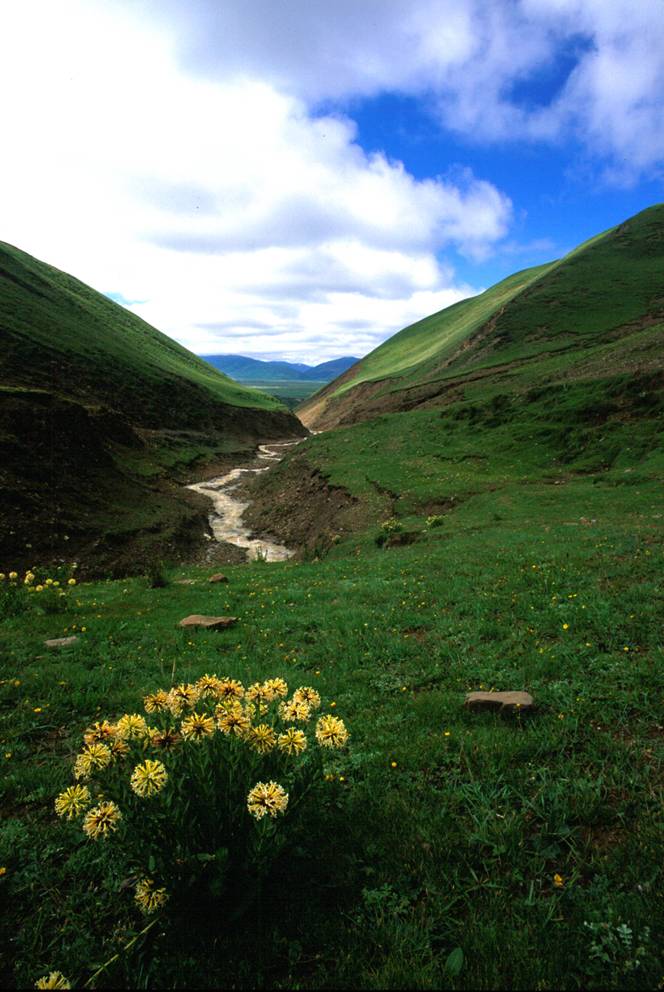 with the material evidence, going right down to the fibres of the plants that were used to make the paper (which can be analysed by peering down the microscope, but also by conducting fieldwork with papermakers and by gathering local knowledge). And let’s not forget the wood that made the boards (which the dendrochronologists in Arizona want to be able to date thanks to the tree-ring evidence) or the pigments that went into decorating it (which can be analysed by UV reflectance spectography by a band based in the Fitzwilliam Museum who normally concentrate on Western illuminated manuscripts). Each of these subjects of microscopic analysis is also dauntingly macroscopic, since you can only make sense of the data when you have mapped both the local ecosystem and Tibet’s trade links with the wider world. It’s truly pioneering work, and as an added bonus it’s usually accompanied by breathtaking images of life on the roof of the planet.
with the material evidence, going right down to the fibres of the plants that were used to make the paper (which can be analysed by peering down the microscope, but also by conducting fieldwork with papermakers and by gathering local knowledge). And let’s not forget the wood that made the boards (which the dendrochronologists in Arizona want to be able to date thanks to the tree-ring evidence) or the pigments that went into decorating it (which can be analysed by UV reflectance spectography by a band based in the Fitzwilliam Museum who normally concentrate on Western illuminated manuscripts). Each of these subjects of microscopic analysis is also dauntingly macroscopic, since you can only make sense of the data when you have mapped both the local ecosystem and Tibet’s trade links with the wider world. It’s truly pioneering work, and as an added bonus it’s usually accompanied by breathtaking images of life on the roof of the planet.
CAMBRIDGE, 28–30 NOVEMBER 2013
The workshop will focus on the introduction of printing and will bring together the world specialists on early Tibetan printing, leading scholars on the materiality and technology of the book in Asia as well as experts in paper and pigment research.
The first part of the workshop will be dedicated to updating current knowledge on early Tibetan printing. It aims at exploring the introduction of this technology in the Tibetan context as a socio-cultural process, something that has never been done before. We will identify indicators to cast light on open questions such as whether Tibetan printing in the 15th and 16th century was a small scale operation or something that had broader involvement and went together with the spread of literate forms of popular religiosity, standardization of monastic curricula and the emergence of certain works as classics.
The second part of the workshop will look at the introduction of printing in Asian contexts cross-culturally, comparing and contrasting (where possible) different experiences, with an eye to recent research on the European ‘printing revolution’ and the debates surrounding it.
Limited places available, please e-mail Michela Clemente if you would like to attend.
Tomorrow I’m heading off to the new Library of Birmingham for a conference entitled ‘Resurrecting the Book‘. When I tell people this, they tend to ask: ‘Is it dead?’ I could point them to a letter sent home my son’s school last week, which read:
“Dear Parent / Carer of Year 8,
We are delighted to inform you that your child has been loaned a copy of A Christmas Carol, which they will be studying in English until the end of the Autumn term. Students will be bringing their copy home to enable them to continue reading and enjoying the novel outside of lessons. We ask that you join us in encouraging students to look after their copy as it will be passed on to other students in the future.
Each copy has been marked with a unique code, which will enable us to keep track of the books. Your child is responsible for returning their copy of A Christmas Carol, at the end of term, by the 19th December 2013. Any books which are not returned will need to be replaced at a cost of £4.99. Please note this is specifically a charge for books that are not returned and not a general charge for borrowing the text.
We look forward to enjoying reading the novel alongside year 8 in the coming weeks.”
I’m sure that a year or two ago the act of borrowing a book from school would have been an everyday affair, completely taken for granted. Now it needs a detailed explanation and a fanfare of celebration. Soon each book will have to come with an instruction manual, and (probably) a charger.
I first learnt the name of William Herle thanks to this website–I posted an image of an illegible signature I’d found a sixteenth-century book and got a response (from Arnold Hunt at the BL) telling me that it was Herle’s. Then I came across the online edition of Herle’s letters, created by Robyn Adams, Alison Wiggins and their team at the Centre for Editing Lives and Letters. And then I started to get interested in Herle himself, as a couple of vivid letters took me into the Elizabethan underworld, which turned out also to be a literary underworld, a place where people forged books as readily as they forged coins.
Herle was an intelligencer–a news-gatherer and secret agent–working for Elizabeth’s spymasters William Cecil, Lord Burghley and Francis Walsingham. His main area of expertise was the Low Countries, which he visited on several occasions, sometimes on his own, sometimes with official delegations (accompanying the duke of Alençon in 1582, following the earl of Leicester’s army in 1585). Despite his evident value to the authorities, he spent much of his life in crippling debt, and his letters mingle their nuggets of ‘intelligence’ with petitions for financial support. But, as David Lewis Jones puts it in the new DNB, ‘his many requests for a permanent position were ignored by his powerful friends and this suggests that they considered him useful but not entirely trustworthy’. Such was the allotted destiny of a double-agent who hung around with the dodgiest of characters in order to keep Elizabeth’s brutal regime on the tracks.
While we have a mine of information about Herle’s activities from the 1560s through to his death in 1588/9, we have no idea when he was born, and know nothing about his early life, save that he was born in the Welsh Marches, the son of Thomas Herle of Montgomery. He seems to have kept up his ties to the borders (an illegitimate daughter was baptized at Guilsfield, near Welshpool, in 1576). We also know that, somewhere along the way, he acquired many tongues. DNB says that ‘he was well educated with a good knowledge of languages, including Latin, Flemish, and Italian, and probably also French and Spanish’.
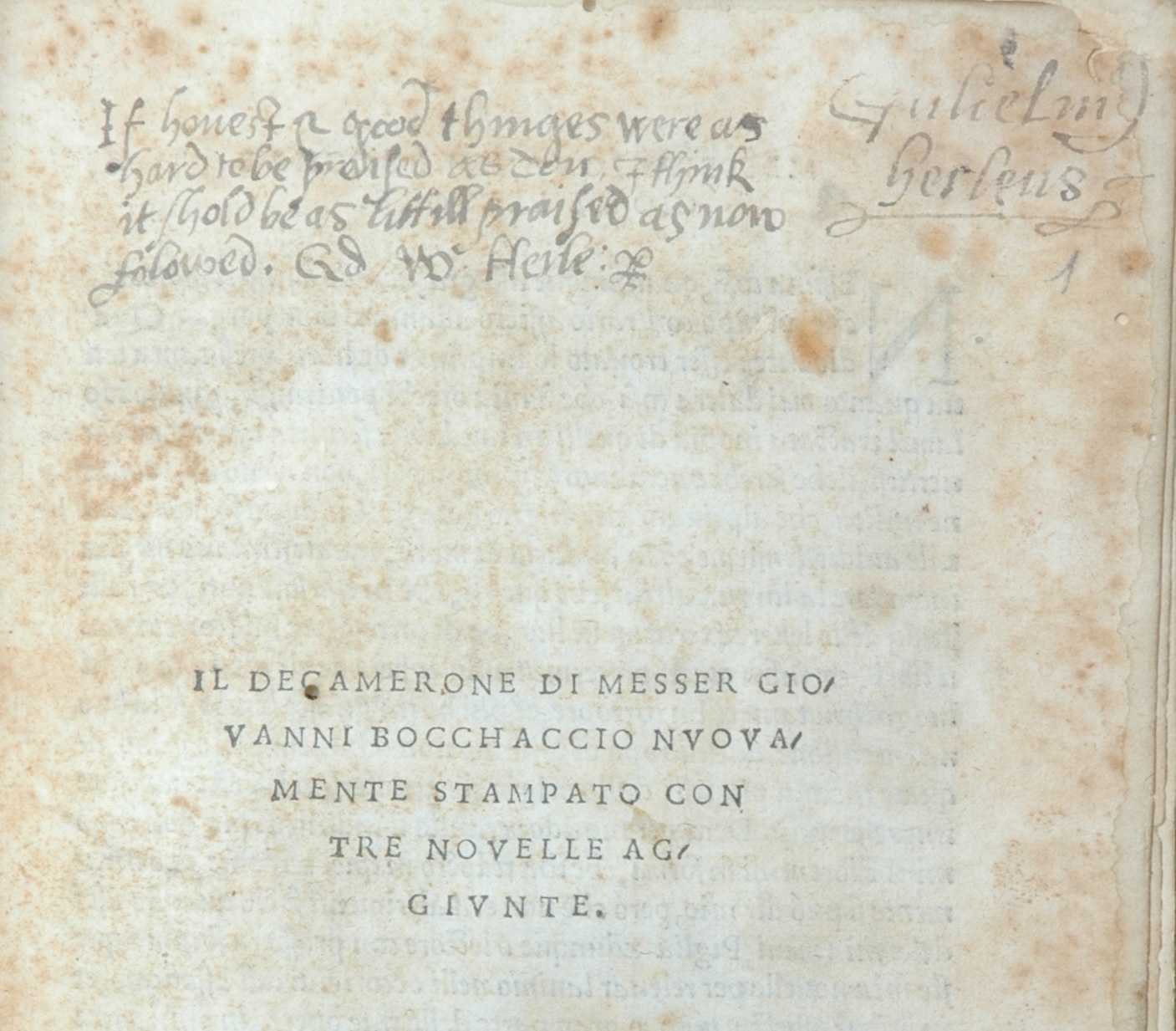 Recently a book has surfaced that might shed some light on Herle’s language-learning, and thanks to the generosity of its current owner I’ve had the privilege of spending some time poring over it. It’s a copy of Boccaccio’s Decameron, in the edition printed by Filippo Giunta in Florence in 1516. The title-page is signed ‘Guilielm[us] herleus’, alongside a cynical epigraph: ‘If honest & good thinges were as hard to be preised as don, I think it [sic] shold be as littill praised as now folowed. Q[uo]d W. Herle.’ The book bears various other Herle signatures, no two of which are alike. And strikingly, offsetting the cynicism, there are also a couple of lovey-dovey marginal inscriptions in which Herle celebrates his relationship with an ‘Elizabeth’. ‘E.H. / W.H. / two hearts in one Body joined as Elisabeth & William’, runs one of them. Who the lady was, we don’t know (there is no evidence that Herle ever married).
Recently a book has surfaced that might shed some light on Herle’s language-learning, and thanks to the generosity of its current owner I’ve had the privilege of spending some time poring over it. It’s a copy of Boccaccio’s Decameron, in the edition printed by Filippo Giunta in Florence in 1516. The title-page is signed ‘Guilielm[us] herleus’, alongside a cynical epigraph: ‘If honest & good thinges were as hard to be preised as don, I think it [sic] shold be as littill praised as now folowed. Q[uo]d W. Herle.’ The book bears various other Herle signatures, no two of which are alike. And strikingly, offsetting the cynicism, there are also a couple of lovey-dovey marginal inscriptions in which Herle celebrates his relationship with an ‘Elizabeth’. ‘E.H. / W.H. / two hearts in one Body joined as Elisabeth & William’, runs one of them. Who the lady was, we don’t know (there is no evidence that Herle ever married).
Besides these signatures, the book contains quite a serious 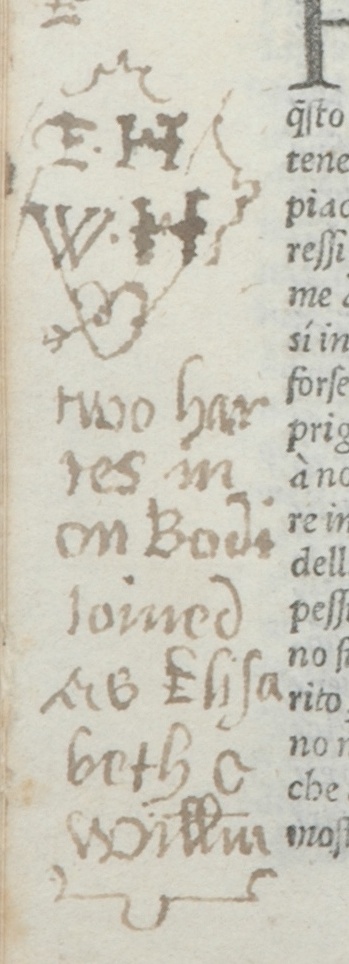 scattering of notes to the text, the majority of which are in Italian. Some analyse the structure of the stories or pick out striking details (the number of people killed by the 1348 plague that provides the spur for the narrative cycle; the ladies’ claim that ‘men are women’s leaders’; a proverb dropped by a crafty abbot, ‘peccato celato mezo perdonato’–‘a sin hidden is half forgiven’; or a range of bogus relics including the finger of the Holy Spirit and the forelock of a seraph). Other bits of marginalia note particular words and phrases (‘paliscalmo’, a little boat; ‘muratore’, bricklayer; ‘inimicheuol tempo’, a terrible time). Some of these may have been penned by other readers, possibly Italian readers–with such tiny samples it’s hard to say how many annotators were involved. But a few of the notes are in English, or they translate Italian terms into English–as when ‘sopra la stangha’ is glossed (correctly, it seems) as ‘a perche for a ha[w]ke’. And one of the tales–a charming narrative which sets out to prove part of the wisdom of Solomon to the effect that women need to be beaten to be kept in line–is marked (in English) ‘to be tra[n]slatyd’. This strongly suggests some kind of language-learning context, in which translation exercises are being set for the students.
scattering of notes to the text, the majority of which are in Italian. Some analyse the structure of the stories or pick out striking details (the number of people killed by the 1348 plague that provides the spur for the narrative cycle; the ladies’ claim that ‘men are women’s leaders’; a proverb dropped by a crafty abbot, ‘peccato celato mezo perdonato’–‘a sin hidden is half forgiven’; or a range of bogus relics including the finger of the Holy Spirit and the forelock of a seraph). Other bits of marginalia note particular words and phrases (‘paliscalmo’, a little boat; ‘muratore’, bricklayer; ‘inimicheuol tempo’, a terrible time). Some of these may have been penned by other readers, possibly Italian readers–with such tiny samples it’s hard to say how many annotators were involved. But a few of the notes are in English, or they translate Italian terms into English–as when ‘sopra la stangha’ is glossed (correctly, it seems) as ‘a perche for a ha[w]ke’. And one of the tales–a charming narrative which sets out to prove part of the wisdom of Solomon to the effect that women need to be beaten to be kept in line–is marked (in English) ‘to be tra[n]slatyd’. This strongly suggests some kind of language-learning context, in which translation exercises are being set for the students.
Perhaps the most delicious feature of the book is that it lets you see Herle in the process of turning Italian. In one of the margins, apropos of nothing in the text, he writes in tiny, precise letters: ‘Io vorrei [I would like] / Giugl[ielm]o herl’. Having already Latinized himself on the title-page, Herle here turns his nam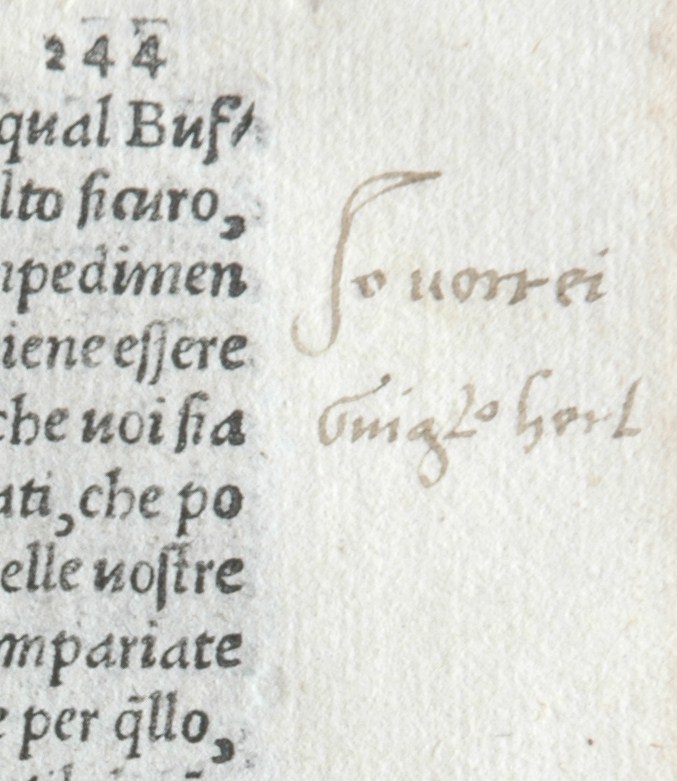 e into an Italian equivalent, and produces it in an unusual hand that looks as if it might itself be aspiring to southern European elegance.
e into an Italian equivalent, and produces it in an unusual hand that looks as if it might itself be aspiring to southern European elegance.
Although they have some features in common, it’s not easy to match the writing in these notes with the later writing of the spy William Herle. But then there is a bewildering variety of styles on display even in his signatures–suggesting this is an identity under construction, playing with different hands and tongues (the perfect training for a spy?) It can only be an educated guess, but my strong suspicion is that these notes are indeed evidence for the early life of the intelligencer. More guesses: it’s the 1540s, we’re in a schoolroom, somewhere in Italy, and Herle is immersing himself in one of the greatest of storytellers.
[Thanks to Guyda Armstrong and Elisabeth Leedham-Green for discussing aspects of this book with me. An exhibition commemorating the 700th anniversary of Boccaccio’s birth is currently taking place at the John Rylands Library, University of Manchester].
A postscript: this book has now been purchased by the Cambridge University Library, and can be called up in the Rare Books Room: classmark 5000.c.73
